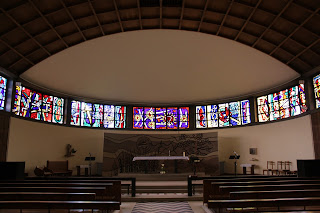Classical, modern and contemporary art and architecture
beautifully combine in exhibitions at St Stephen Walbrook. The reordering of
the church undertaken in the 1980s sensitively introduced significant examples
of modern art (travertine marble altar by Henry Moore and dazzling kneelers by
Patrick Heron) within Sir Christopher Wren’s masterpiece, which also contains
significant woodwork and carving by William Newman. Newman’s dark wood
panelling provides a dramatic backdrop to the regular programme of contemporary
art exhibitions that the church hosts. This marvellous blend of old and new
provides a richly contemplative space in which to display and view art.
London Ablaze: the
Glass Sellers' Great Fire Schools Project exhibition, Thursday 1st
& Friday 2nd September, 10.00am – 4.00pm
As part of celebrations to mark the 350th anniversary of the Great Fire, the Worshipful Company of Glass Sellers of London, a City Livery
Company, has chosen 10 London secondary schools each to design a piece of glass
artwork on the theme of the Great Fire, in collaboration with a leading
contemporary glass artist.
The resulting works from these collaborations will be on
display at an exhibition, London Ablaze, at the church of St Stephen Walbrook,
next to the Mansion House, at the heart of the City on Thursday 1st and Friday
2nd September (10am-4pm). The Friday is the 350th anniversary of the day the
Great Fire started.
Early in 2016 the Glass Sellers’ Company selected ten
artists and ten schools, allocating an artist to each school. Up to 15 students in Year 8 or 9 (age range
13-15) were chosen by each school to work with the artist. The process started
by pupils learning about what happened during the Great Fire. They then worked
with the artist for at least a day to design a work that interpreted the
pupils’ vision of the Great Fire. The artists have then produced the works in
their studios.
The ten works are also being judged, with the winning
school, teacher, pupils and artist receiving a glass work made especially by
Andreya Bennett. The winner will be announced at a reception in the Church on
the evening of Thursday 1st September.
commission4mission, Reflection, Monday 6th – 16th September, Monday – Friday 10.00am – 4.00pm
commission4mission encourages churches to commission
contemporary art. This will be the group’s fourth exhibition in the setting of
St Stephen Walbrook.
The theme of the show will be ‘Reflection’ and, as in
previous years, will feature a wide variety of work from longstanding and new
members. ‘Reflection’ is intended as a broad theme open to wider
interpretation. Their artists will showcase their individual engagements with
this theme and we hope that the range and variety of work, both in terms of
content and media, will give pleasure and prompt reflection.
Reflection: consideration; contemplation; idea; impression;
meditation; observation; opinion; rumination; view; absorption; cerebration;
cogitation; deliberation; imagination; musing; pensiveness; speculation; study;
brainwork; pondering.
commission4mission’s Chair, Peter Webb, says: “We are very
fortunate to be able to exhibit regularly at St Stephen Walbrook. The
exhibition always attracts a great deal of attention in the City. As before,
interpretation of the theme is up to individual artists, and no doubt we will
have the usual amazing variety and originality in the work submitted.”

The Shadow of Angels
- Kim Poor, 3rd – 29th October, Monday – Friday 10.00am – 4.00pm
Brazilian artist Kim Poor will exhibit a series of paintings
in various mediums, including her unique technique of glass fused on steel
plate, baptised ‘Diaphanism’ by Salvador Dali. She is based in London and Rio
de Janeiro and her work has been exhibited worldwide, most recently in Brazil,
Belgium & Greece, with successful solo shows at the Museum of Modern Art in
Rio and in São Paulo.
The theme of the exhibition, which is curated by Edward Lucie-Smith, is the universal appeal of angels and their presence and
significance in our lives. Their iconography has been a unifying force
throughout time and appears in all religions and cultures. Especially in these
troubled times angels represent our need for reassurance in a very unstable
world. They are our protectors, guides and spiritual messengers; a bridge
between us and the Divine.
National Society of
Painters, Sculptors & Printmakers, Monday 21st November – Friday 2nd December,
Monday – Friday 10.00am – 4.00pm
The second group show by National Society artists to be held
at St Stephen Walbrook. The National Society was formed in 1930 to meet a
growing desire among artists of every creed and outlook for an annual
exhibition in London, which would embrace all aspects of art under one roof,
without prejudice or favour to anyone. Its members have included: Mark Gertler,
Jack B Yeats, L S Lowry, David Bomberg, W Russell Flint, Henry Moore, Bernard
Meninsky, William Nicholson, Graham Sutherland, C R W Nevinson, Frank Dobson
and Bernard Adams among others.
------------------------------------------------------------------------------------------------
Corinne Bailey-Rae - Stop Where You Are.
































